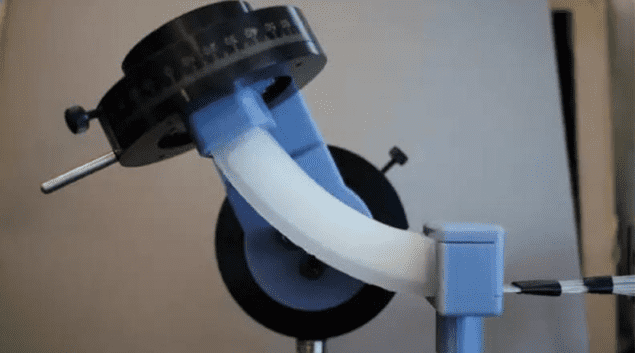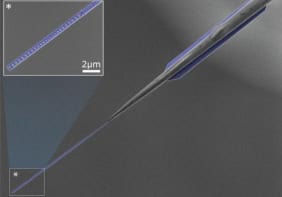
Elastic foams that can detect deformities in their shape have been created by scientists in the US. The materials use a combination of optical fibres and machine learning techniques to measure deformations. The research could lead to the development of soft robots that are more responsive to their environment and better able to cope with damage, the researchers claim.
Our traditional view of robots is that they are very machine-like and made from hard materials like plastics and metals. The aim of soft robotics, however, is to make robots that are soft, flexible and more like living organisms.
For these robots to reach their full potential they need to know their own shape and sense changes and deformations in it. Such capabilities could improve their locomotion, enable them to protect themselves, and help them recover from being damaged.
Disoriented movement
A robot operating autonomously could easily injure itself without realising, says Robert Shepherd, who heads the Organic Robotics Lab at Cornell University in New York. “It’s going to continue moving its limb and thinking its hand or foot is going to be in one position, when it’s actually going to be in a different position,” he says.
Most previous attempts to build self-sensing systems have involved surface mounting or embedding sensors that each detect something specific, such as a change in pressure or the curve of a robot limb. But these systems give limited information about the robot’s overall shape and configuration, and any changes in these parameters. “We need skins, or internal neural-like sensors, to communicate this information three-dimensionally and continuously,” Shepherd says.
To help move towards such a system, Shepherd and his colleagues placed an array of 30 optical fibres in a silicon foam and then bent and twisted it more than 2000 times while measuring changes in the light exiting the optical array.
“The optical fibres transmit light into the foam, that light gets scattered in the foam, and some of that light re-enters the fibres,” Cornell’s Ilse Van Meerbeek told Physics World. “When the foam is deformed, the light re-entering the fibres changes in intensity. We use that change in intensity to build a model that maps the light intensities to the deformation of the foam.”
100% accuracy
This allowed the team to train a machine learning system so that it could predict with 100% accuracy whether the foam had been bent upwards or downwards or twisted anti-clockwise or clockwise. It was also able to sense the magnitude of the deformation with an average error of just 0.06°. “We twisted and bent the foam to a range of angles spanning about 180° degrees,” van Meerbeek says.
The current set-up uses a large light source and camera that are external to the foam. This would not be practical for an autonomous robot, but the team says that this study was designed to demonstrate the performance of the prediction model, rather than address the engineering challenges involved in building a robot. They add that the light and camera could be replaced with much smaller LEDs and photodiodes, which could then be integrated, along with the optical fibres, into soft actuators to build a robotic system.
Although the current device can only detect four types of deformation, the team believes it could be used to detect other shape changes and more arbitrary deformations, particularly if combined with more powerful artificial inteligence techniques. “We have shown that we can detect bend and twist, but as long as the deformation causes a change in light scattering, we expect that in principle we can build a model to detect it,” explains van Meerbeek.
According to van Meerbeek, soft robots that can sense their own shape can be more reliably controlled than current robotic systems. “This may enable soft robots to be useful household aids or companions,” she says. “It could also enable more comfortable prostheses that have better sensing, allowing them to perform more complex tasks.”
The foam is described in Science Robotics.



